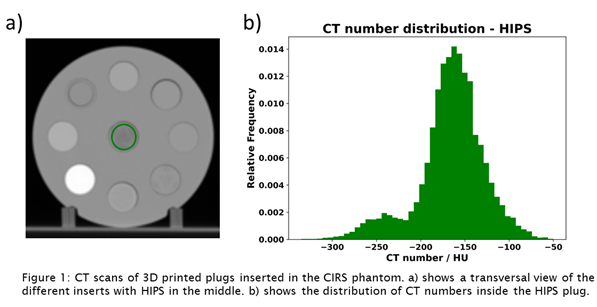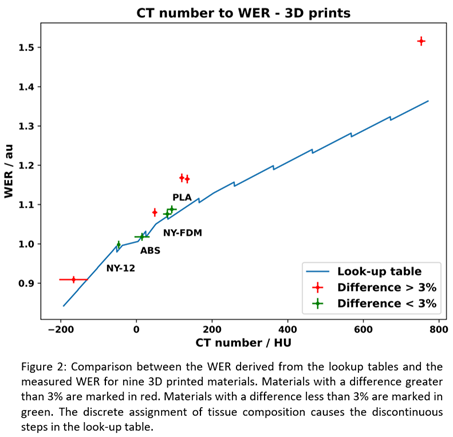Characterization of 3D printed material for end-to-end test phantoms in proton therapy
PD-0585
Abstract
Characterization of 3D printed material for end-to-end test phantoms in proton therapy
Authors: Jacob Brunner1,2, Markus Stock2,3, Dietmar Georg1, Barbara Knäusl1,2
1Medical University of Vienna, Department of Radiation Oncology, Vienna, Austria; 2MedAustron Ion Therapy Center, Medical Physics, Wiener Neustadt, Austria; 3Karl Landsteiner University of Health Sciences, Medical Physics, Wiener Neustadt, Austria
Show Affiliations
Hide Affiliations
Purpose or Objective
End-to-end (E2E) tests in radiation oncology aim to mimic a complete patient workflow by employing a phantom suitable for both imaging and dosimetry. In proton therapy tissue equivalency of phantom materials is essential, i.e. the matching of the CT numbers (CTN) with the stopping power ratio (SPR) assigned by a heuristic calibration curve [1] is the basis for any accurate comparison of dose prediction and measurements. This work aims to characterize 3D printed materials for the design of a versatile E2E test phantom for proton therapy.
Material and Methods
For nine samples (5x5 cm2, thickness t = 1 cm) the water equivalent thickness (WET) was measured via a water column (Peakfinder, PTW) in a 148.2 MeV proton beam.
To assess print quality/homogeneity, all measurements were repeated at three different points of the samples. Additionally, a CIRS CT calibration phantom equipped with cylindrical plugs from the same 3D printed materials was scanned at the CT scanner (kVp = 120V, slice thickness = 2mm) to determine the CTN (Fig1a), which in turn were used to derive the predicted SPR from the treatment planning system [2].
The employed 3D printing techniques were fused deposition modeling (FDM) (FunmatPro410, Intamsys), stereolithography (STL) (Form3, Formlabs) and selective laser sintering (SLS) (EOS P396, EOS).
FDM printed materials included: acrylonitrile butadiene styrene (ABS), polylactic acid (PLA), high impact polystyrene (HIPS) and Nylon (NY-FDM). STL materials were: Durable10K (DUR), Tough2000 (TGH) and WhiteResin (WR). Nylon-12 (NY-12) was produced using SLS.
Results
Measurements revealed a water equivalent ratio (WER = WET/density) ranging from 0.91 to 1.52 with a measurement uncertainty below 1%.
From the determined HU values of all materials the mean and standard deviation (SD) were derived (see Fig1b for HIPS) and subsequently used to calculate the WER (Fig2). For four materials a difference of less than 3% between predicted and measured values was found. These were NY-12 (measured: 1.01 ± 0.01; predicted: 1.00 ± 0.01), ABS (1.04 ± 0.01; 1.02 ± 0.01), NY-FDM (1.08 ± 0.01; 1.07 ± 0.01) and PLA (1.09 ± 0.01; 1.07 ± 0.01). The difference between prediction and measurement was larger 3% for HIPS (lowest measured WER = 0.91 ± 0.01; predicted: 0.87 ± 0.04), ELA, WR, TGH and DUR (highest measured WER = 1.52 ± 0.01; predicted: 1.35 ± 0.01). The predicted WER SD was largest for HIPS (4.7%), while for the other materials SD ranges between 0.1%-1.3% were found.

Conclusion
The investigated 3D printed materials will enable efficient manufacturing of E2E test phantoms for proton therapy. The most promising surrogates seem to be ABS for soft tissue, Nylon-12 for breast/fatty tissue and PLA/FDM-Nylon for skin/cartilage. The next steps will include producing human prototypes with various inserts for dosimetry, e.g. a neck phantom capable of mimicking patient weight loss.
[1] Schneider, U. et al. (1996) - doi.org/10.1088/0031-9155/41/1/009
[2] Peters et al. (2021) - doi.org/10.1016/j.radonc.2021.07.019